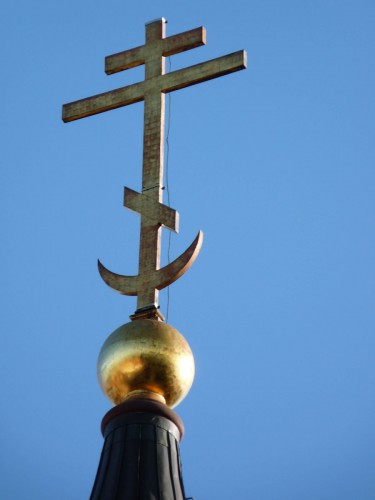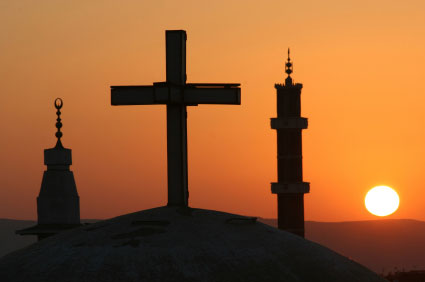 Please let me make a few things clear before we look at a short, but very disturbing, Associated Press report out of Egypt.
First of all, it is clear that conditions in Egypt vary greatly from location to location. There continue to be positive signs of cooperation between various factions in negotiations in Cairo (although reports are mixed on that, too). Meanwhile, there are hot spots in other parts of the country.
Please let me make a few things clear before we look at a short, but very disturbing, Associated Press report out of Egypt.
First of all, it is clear that conditions in Egypt vary greatly from location to location. There continue to be positive signs of cooperation between various factions in negotiations in Cairo (although reports are mixed on that, too). Meanwhile, there are hot spots in other parts of the country.
Second, journalists face a special handicap right now -- in the current state of confusion in the military and among police -- because there is no safe, supposedly neutral, source to turn to for facts during violent conflicts. A report that merely quotes the authorities is, in effect, a biased report. The authorities are, in many parts of Egypt, almost certainly part of the conditions causing the conflicts.
Third, this means that when covering conflicts between the religious majority and various religious minorities, journalists simply have to quote multiple sources and then note the contrasts in the resulting information.
Now, with all of those journalistic factors in mind, let's look at the following short AP report (which was sent to me by several readers and another GetReligionista, as well):
CAIRO (AP) -- Egyptian security officials say Christian and Muslim families have clashed south of Cairo in a dispute over a romance between children from the two families. The fathers from both families have been killed and a crowd of Muslims has torched a church.
Mixed relationships are taboo in Egypt, where the Muslim majority and sizable Christian minority are both largely conservative. Such relationships are often the source of deadly clashes between the faiths. Christians also complain that they face discrimination.
Officials say a crowd of Muslims encircled the church in Soul on Saturday and set the building on fire after police and soldiers took those inside to safety. The officials spoke on condition of anonymity because they were not authorized to speak to the press.
This is a pretty typical report from Egypt, at the moment. The point in this story is that there was a conflict between Muslims and Coptic Christians, a conflict sparked by tensions on both sides about an interfaith romance.
Both fathers died, as a result.
What does that fact imply? Well, it implies that the Muslims killed the Christian father and the Christians killed the Muslim father. In the midst of that bloodshed, Muslims burned the church in Soul.
However, there are other reports on these events that do not settle for quoting local officials. Some of these reports from Coptic sources say that the priest and other clergy are missing.
If most of the information in these reports is accurate, it also seems that the AP report failed to ask some crucial questions about the nature of this interfaith conflict. It appears that there were three groups of people in this drama -- two groups of Muslims and then the Coptic Christians.
Here is the crucial question: Who killed each of the fathers?
Dig into this Google News search and, once again, you get into a puzzle of sources. It appears that the majority-voice authorities are working from one set of facts, or a set of facts with some interesting gaps, while the minority voices are reporting additional information from ground level. This creates another set of facts.
 Consider this passage about this bloody puzzle drawn from an Assyrian International News Agency report:
Consider this passage about this bloody puzzle drawn from an Assyrian International News Agency report:
This incident was triggered by a relationship between 40-year-old Copt Ashraf Iskander and a Muslim woman. Yesterday a "reconciliation" meeting was arranged between the relevant Coptic and Muslim families and together with the Muslim elders it was decided that Ashraf Iskander would have to leave the village because Muslims torched his house.
The father of the Muslim woman was killed by his cousin because he did not kill his daughter to preserve the family's honor, which led the woman's brother to avenge the death of his father by killing the cousin. The village Muslims blamed the Christians.
The Muslim mob attacked the church, exploding 5-6 gas cylinders inside the church, pulled down the cross and the domes and burnt everything inside. ... Coptic activist Wagih Yacoub reported the mob has broken into Coptic homes and has called on Copts to leave the village. "Terrorized Copts have fled and some hid in homes of Muslim neighbors," he added.
There is quite a bit of detail there. In particular, I find it interesting and totally believable that while some Muslims were attacking the church, others were helping to hide the Coptic believers who were said to be on the run from the mob.
This is, of course, a story drawn primarily from Coptic sources. It says that right in the text.
The point that I am trying to make is that the AP report is drawn only from official, majority-voice sources and, in Egypt right now, that tells us almost nothing about the quality of the information. This is a journalistic problem. It is a problem of balance. The story, I believe, should be drawing from sources on both sides of this fatal conflict. Journalistic problems demand journalistic solutions.
However, let's start with a basic question about a pivotal fact in this report: Who killed the Muslim father? Who killed the Christian father (if, in fact, that happened)?
The AP story contains a gaping hole where it needs two crucial facts. Otherwise, it should openly say that its information is incomplete.
